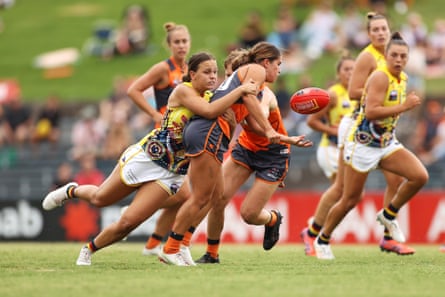As we near the end of round seven of the AFLW’s 10-round home-and-away season, we would ordinarily be in a good position to assess overall team performance and identify genuine contenders for the premiership cup. But given the complexity of this season’s fixturing, care of Covid-19, and the varied and inequitable experiences of, and impact on, different clubs, a true measure of team performances would be loaded with qualifications, caveats and asterisks.
On the face of it, the division between who can, who might, and who cannot is clear enough. The top six teams – from first position down: Adelaide, Fremantle, North Melbourne, Melbourne, Brisbane and Collingwood – share much in common, including the notable fact they are all foundation teams with five and a half seasons of AFLW experience behind them. Compare this to the bottom six – from last: St Kilda, West Coast, Geelong, GWS, Carlton and Richmond – which are almost all expansion teams. The two exceptions - GWS and Carlton – have unique challenges which could fill another article entirely at the very least.
However, beyond the systemic differences facing each club, the many challenges thrown up by Covid in 2022 have served to highlight and exacerbate the differences in outcome and various inequities across the competition, and will continue to shape how the season plays out.
At the end of this past weekend, both ladder leaders and premiership favourites, Adelaide and Fremantle – and third-placed North – have played one more match than their immediate challengers in fourth and fifth place, Melbourne and Brisbane. While this disparity will level out after Monday night’s match, when Brisbane host Melbourne at Metricon Stadium, this means Brisbane will have played four matches in 15 days including two on the road. Taking on the in-form Demons in such a tight turnaround, albeit at home, will present added difficulties for the reigning premiers, particularly as Melbourne have benefited from consistent week-long breaks and limited interstate travel. With (to be confirmed) matches scheduled against in-form North and the unpredictable Tigers at their Punt Road home, the run home will test the Lions’ conditioning and resilience.
However, their true mettle might not be tested until the finals, as they will not face Fremantle before then. Given Brisbane’s only loss came at the hands of premiership contenders Adelaide in round one – a notoriously unreliable predictor of season outcomes – measuring the true potential of Brisbane’s back-to-back campaign is fraught, to say the least.

By contrast, Fremantle’s match against Geelong was postponed so, when they face Adelaide at home on 26 February, they will be coming off a 14-day break – a much-needed rest after spending the first four weeks in an interstate hub. With only one loss to North (away), and this extended break aiding their recovery, even tough match-ups against Adelaide and then Melbourne would ordinarily bode well for them come finals. That is, if one ignores the uncertainty surrounding their final matches: the Cats match is yet to be rescheduled, and the AFL has not even proposed a round 10 opponent or venue for the Dockers.
Melbourne’s performance this season has been consistent and impressive, aided by a favourable fixture, including meeting only one top six opponent to date. The run home will be harder. Their one loss was to Adelaide away and, with an – admittedly strained – Brisbane on the road followed by North and the Dockers away, Melbourne’s premiership potential will become clearer.
North Melbourne’s comfortable dismissal of Collingwood to close out the weekend’s matches adds some spice to the finals contest, although they have not travelled well (beyond home matches in Tasmania), and with games against Melbourne and Brisbane to come will face their toughest test to date.
To compound the complications of making any kind of predictions, there are three matches from previous rounds (rounds two, three and five) still to be played, while one played this week – Gold Coast v Brisbane – was brought forward from ‘round 11’, a round invented to clean up any outstanding matches, although not, presumably, intended to be carried out mid-season.
Scheduling football matches while battling a global pandemic is a huge ask for any organisation. The constant re-fixturing has had a particularly deleterious impact on some clubs more than others, further compounded by inequitable travel requirements and turnaround times between matches. Given that Adelaide and Fremantle, two of the most Covid-affected of clubs, occupy the top two positions on the ladder, a premiership win for either should carry not an asterisk beside the result but, rather, five stars.
